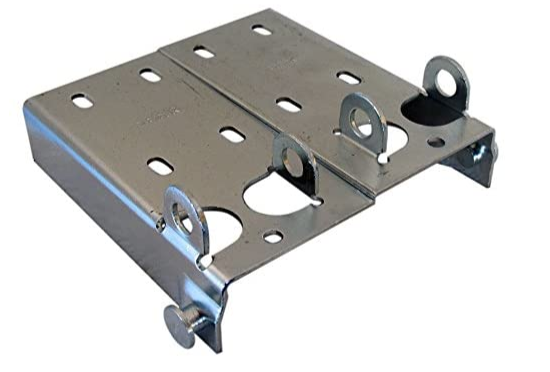Securing Stability: The Importance of Garage Door Bottom Brackets
Garage doors are compound structures with many moving parts. Bottom brackets are significant for these parts since they facilitate the smooth operation of the garage door. Although the opener receives the majority of attention, the garage door bottom bracket, a less noticeable part, deserves praise as well. These uncomplicated brackets ensure your door slides effortlessly down the track, keeping alignment correct and acoustically quiet.

Importance Of Garage Door Bottom Brackets:
The garage door mechanism’s bottom brackets are key components that perform multiple vital functions.
Supporting Weight:
Particularly when the garage door is closed, the bottom brackets support the weight of the whole door. By offering structural support and stability, they ensure the door stays balanced and properly functions.
Anchor for Lifting Cables:
Bottom brackets anchor the lifting wires attached to the garage door springs. The bottom brackets must be installed and aligned correctly for the lifting cables to operate efficiently and safely.
Alignment and Movement:
As the garage door panels travel along the rails, bottom brackets assist in keeping them in alignment. They protect the door and tracks by ensuring it runs smoothly without binding or misalignment.
Types Of Garage Door Bottom Brackets:
Standard Bottom Brackets:
These are the bottom brackets that are most frequently seen on residential garage doors. Typically, for strength and longevity, they are composed of robust metal, like steel or steel that has been zinc-plated. The lifting wires can be attached to and secured in place using the slots and holes found in standard bottom brackets.
Reinforced Bottom Brackets:
Expanded bottom brackets are utilized when more strength and longevity are needed. These brackets offer more support and stability, especially for large or heavy garage doors, because they are frequently larger and heavier than regular brackets.
Low Headroom Bottom Brackets:
Low headroom bottom brackets reduce the space between the top of the door and the ceiling in garage doors with limited headroom. Their unique design maintains performance and safety while enabling the door to function smoothly in low clearance situations.
Adjustable Bottom Brackets:
Adjustable bottom brackets provide installation and maintenance flexibility. They adjust the door’s alignment and track spacing precisely, guaranteeing peak performance and reducing wear and tear on the door’s constituent parts.
Maintenance Of Garage Door Bottom Brackets:
The bottom brackets of the garage door requires care as it is the core reason behind the dependability of the garage door system. Here are some pointers for maintenance to remember:
Regular Inspection:
Inspect the bottom brackets for rust, wear, and damage. Look for any loose connections, bends that need to be repaired.
Lubrication:
The moving components of these brackets need to be lubricated. By lowering friction, lubrication helps keep garage doors from wearing out and guarantees smooth operation.
Tighten Fasteners:
Examine the screws, nuts, and bolts holding the bottom brackets to the tracks and door frame. Tighten any loose bolts to stop the brackets from falling free while the machine is operating.
Track Alignment:
Please verify that the bottom brackets and tracks are positioned correctly and are parallel by looking at their alignment. The door may operate unevenly or jam due to misaligned tracks, which could result in damage.

Replace Worn or Damaged Brackets:
Replace the bottom brackets right away if you see any indications of severe wear or damage, such as cracks, deformation, or corrosion. The garage door system is functioning and safe.
Signs Of Garage Door Bottom Brackets Damage
Bottom brackets can deteriorate or break with time, as can any mechanical part. The following warning indicators may suggest that your bracket requires attention:
- Visible damage: Examine the bracket for rust, bends, or cracks.
- Uneven door movement: One possible cause of a tilting or wobbling door when opening or closing could be a misplaced or broken bracket.
- Grinding noises: These noises indicate that a broken bracket is causing the door to bind on the track.
- Open or close door: Increased friction may be caused by a damaged bracket.
- Gaps between the door and the floor: Uneven gaps around the closed door’s bottom edge could indicate a problem with alignment brought on by a broken bracket.
Conclusion:
The garage door bottom brackets is essential for maintaining weight support, guaranteeing correct alignment, and enabling smooth garage door movement. Bottom brackets, which serve as anchor points for lifting cables, ensure that the force produced by garage door springs is distributed appropriately, reducing the chance of malfunction or damage and avoiding undue stress on other parts. Homeowners and garage door experts must comprehend the many bottom brackets and how they work. Homeowners may guarantee the dependable and secure operation of their garage doors for many years to come by adhering to recommended maintenance procedures and taking quick action when there are problems with bottom brackets. The durability and stability of the garage door’s bottom brackets determine whether the door opens to let in a car or closes to protect possessions.

